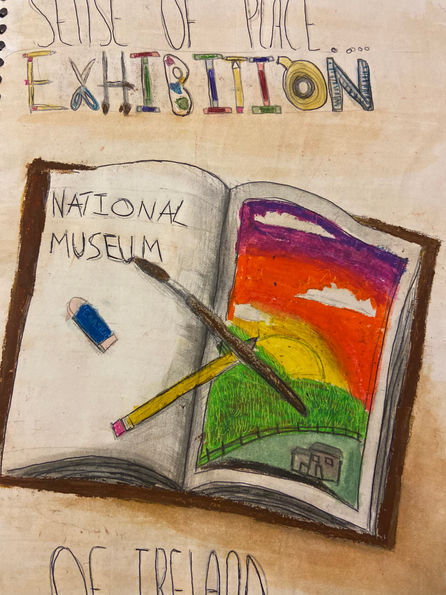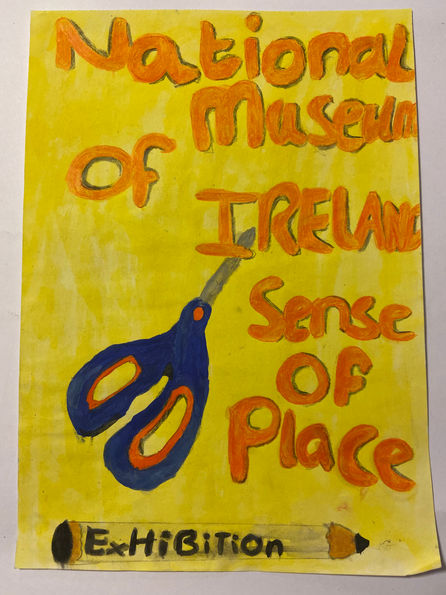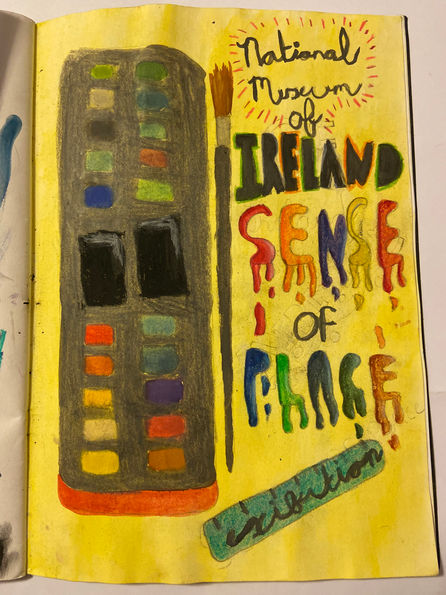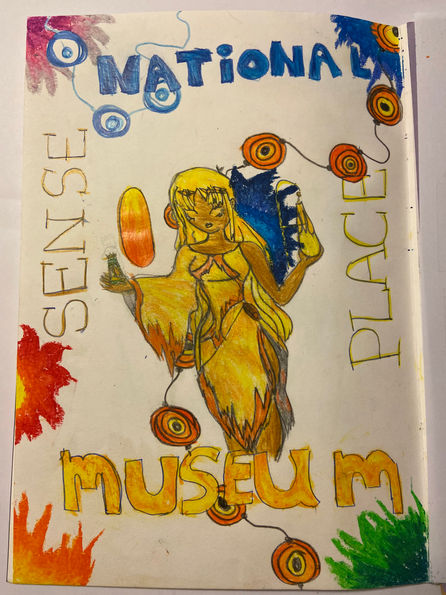
Teaching Practice
Post Primary Teaching
"Art, freedom and creativity will change society faster than politics"
- Victor Pinchuk
School placement aims are to develop our own teaching style that draws from our art practice. Growing in confidence to teaching, establishing classroom management skills and understanding assessment methods. Through reflection we became reflective practitioners, learning from our experience. Over the last 2 years of the Professional Masters of Education, I completed my school placement in 2 different Post Primary school. I worked with students from junior cycle and leaving certificate. I also engaged in team teaching, portfolio classes, observations and yard duty. In PME 1, I worked in an all girls catholic school and my PME 2 placement took place in a mixed gender DEIS school.
This page features a collection of Units of Learning I have delivered.
St. Mary's College, Arklow, Co. Wicklow (PME 1)

St. Mary's College was established by the Sisters of Mercy in 1903. It was originally a bording school until 1970 when day education became the priority over students boarding. Since 2006, the school has been under the trusteeship of CEIST (Catholic Education Irish School Trust) since 2006.
The school is single sex, all girls. With 560 students. The school aims to create a supportive, happy and caring environment. A strong partnership is formed between teachers, students, parents and the Arklow community. Each teacher educates their students on how to develop a healthy physical and social environment inside and outside of school.
St Mary's is a Creative Ireland school. Art is values highly and there is a range of projects for the students to engage in. There is a open space called the Creative Hub, where students can express their artistic skills during break times.
Unit of Learning 1
Low Relief Bookcraft
1st Year
Theme:
Mythical Creatures found beyond the Trees
Aim:
The students will research the theme Beyond the trees through bookcraft. Using their imagination they will develop and realise their project through bookcraft. The students will design a mythical creature that might be hiding beyond the trees. Focusing on designing a low relief cover, sculpting and binding the book together. While addressing shape, texture and space.
Concentrating on line, shape and texture.
Learning Outcomes:
Critical and visual language:
-
Analyse their work, or that of another, using appropriate vocabulary and knowledge.
-
Reflect on their own, or another’s, craftwork through the use of critical and visual language
Drawing
-
Develop their ideas for craftwork through drawing
-
Investigate their own personal approach to craftwork through the technical and creative application of drawing and mark-making.
Visual culture and appreciation
-
Identify the historical or contemporary skills and materials used in craft works from a number of different crafts
Art elements and design principles (AEDP)
-
Identify the use of art elements and design principles within an artwork
-
Apply their understanding of the art elements and design principles to make an artwork
-
Describe art elements and design principles as they are used across a number of different crafts
Media
-
Use media to create craftwork
Learning Intentions:
-
Unpack the theme through mind mapping and Think Pair Share activities.
-
Design a variety of thumbnail sketches of mythical creatures, a hybrid or imaginative.
-
Upscale one design to A5, create a resolved sketch of one creature. Focus on mark making, texture and shapes.
-
Trace and transfer the drawing to the bookcover, sketch the drawing in forms of shapes.
-
Analyse mythical creatures from Irish folklore. Question the story behind the creatures.
-
Sculpt a low relief creature and mythical background from card, cardboard and gold foil.
-
Manipulate the cardboard by cutting and overlapping different shapes to create a variety of textures.
-
Write a short story detailing the life of the mythical creature.
-
Evaluate each element of the project, focus on identifying strengths and weaknesses.
-
Bind the book together using a needle and thread.
-
Engage in Peer Evaluations, assess each other's work and celebrate their achievements.

Teacher's Visual Aid
 |  |
|---|
Collection of Students Work
Teaching and Learning Resources
Chocolate & Mixed Nuts

Graphic Design & Film Studies

Teaching and Learning Resources
Film Studies:
Graphic Design:
Unit of Learning 2
Art History: Art Appreciation
5th Year
Theme:
Art History, Art Appreciation section
- Film Studies
- Graphic Design
Aim:
At the end of the Unit of Learning the students should be able to answer a higher level appreciation question on Film Studies and Graphic Design.
They should have gained knowledge of a variety of films and genres. The students should understand different filmmaking and animation techniques.
Students should be able to use a range of communication and critical thinking skills to evaluate Graphic Design.
Learning Outcomes:
Film Studies:
-
Use critical and visual language to describe diverse film work
-
Respond to and critique works of famous directors and film production crew.
-
Illustrate their exam essays with labelled sketches.
-
Describe examples of historical and contemporary film using film terminology.
-
Explain the use of art elements and design principles in examples of film, focusing on design and colour theory.
-
Describe the use of media in examples of films they have studied.
Graphic Design:
-
Analyse graphic designers work, using critical and visual language.
-
Use drawings to create a logo to communicate their personal outlook or understanding of the design brief and instagram.
-
Critic the design concepts and imagery made by historical and contemporary graphic designers.
-
Examine design work through the use of art elements and design principles.
-
Describe the use of media in examples of traditional and contemporary design work.
Learning Intentions:
Film Studies:
-
Know the key moments in the history of Film.
-
Understand film terminology and be able to define the key words.
-
Identify technological develops in film over the years.
-
Observe and analyse 2 films, Frozen and Brooklyn.
-
Critique Frozen and Brooklyn. Focus on character development, design concept, colour theory, costume design and emotion of the movie.
-
Learn how to structure a Film Studies essay, focusing on previous exam questions.
-
Produce vibrant research notes with sketches.
-
Question film as a fine art medium.
-
Discuss moving images from a variety of artists, including Ms. Kenny’s work.
Graphic Design:
-
Understand the history and layout of posters focusing on Film posters.
-
Know what a logo is and its function. Be able to recognise popular logos and link
-
Research the history of one Coca Colas logos over the last hundred years. Learn about company identity and logos.
-
Follow a design brief and create a logo for instagram focusing on colour, composition, shape and balance.
-
Identify different types of advertising.
-
Appreciate the function of advertising and how companies use advertising to promote their products or services.
-
Link colour theory to advertising and gendered advertisements.
-
Understand what packaging function is, what is effective packaging and the benefits of eco friendly packaging in contrast to non reusable.
Glenart College, Arklow, Co. Wicklow (PME 2)
Glenart College is under the patronage of Kildare and Wicklow Education and Training Board. The school was setup in 1905, more recently they have moved into a new state of the art building. The group take great pride in the progressive and friendly learning environment they have created. The schools ethos is multi-denominational, students learn to value and cultivate their faith, while at the same time learning to appreciate and value the beliefs of others.
The school is a co-educational secondary school, with the view students should have equal opportunities regardless of gender. With 360 students and 54 teachers the school offers a range of academic and practical subjects, ideal for all students abilities and interests. The class sizes are small so the teachers can have more time to engage with students on a individual level.
Art is valued highly in the school, with many students being encouraged to go to art college. The art room is vibrant and the walls showcase students work. The hallways also feature the students creative achievements.

Unit of Learning 3
Our Habitat, Ecofeminist accordion book
5th Year
Theme:
Our Habitat
Aim:
To create an accordion ‘bookscape’ that documents a process of experimental drawing techniques that interpret the theme of ‘our habitat’.
Introduce text alongside the artwork created and challenge learners to work with a grid and experiment with the relationship between text and imagery to create harmony on each page.
Assemble a low relief front cover, demonstrating how to manipulate and interpret 2D artwork as a sculptural piece.
Learning Outcomes:
Research:
Looking:
-
Use critical and visual language to describe an artwork.
-
Experience the natural and built environment as a source of inspiration.
Recording and documenting:
-
Record visual information through a variety of media and techniques.
-
Capture their interpretation of the world in a physical/digital way.
Experimenting and interpretation:
-
Produce an annotated visual record of their enquiry. - Experiment with ideas, media and techniques.
Contextual enquires:
-
Use the wider context of how the word is continually changing, socially, politically, ethically, etc. in their work.
Process:
-
Articulate and annotate their research process and decision making
-
Draft a selection of drawings and studies that support their ideas and work
Create:
Making:
-
Develop concepts in imaginative and creative ways.
-
Interpret primary sources including the natural and built environment and the human figure as a source of inspiration.
Contextual enquiries:
-
Apply the art elements and design principles in creating and evaluating their work.
Process:
-
Create a selection of drawings, studies and realised work.
-
Relate their research, processes and decisions that led to their realised work.
Realisation/ Presenting:
-
Curate and present their work in a considered way
Respond:
Analysis:
-
Question established and new ideas and work.
Contextual enquiries:
-
Locate their work in relation to other artwork within a particular context/s (stylistically,socially, politically, ethically, etc.)
Impact and value:
-
Experience art through sensory and/or emotional responses.
Critical and personal reflection
-
Discuss the development of ideas and work from conception to realisation
Process:
-
Justify their research, process, decision making and realised work.
Learning Intentions:
-
Become aware of Development Education and the United Nations Sustainable Development Goal 5 Gender Equality and Goal 15 Life on Land.
-
Unpack Ecofeminism and engage in sustainable interventions in and outside of school.
-
Assemble an A5 accordion book through a series of paper folding and cutting.
-
Observe and document a range of primary sources found in our habitats.
-
Build handmade drawing tools from natural material. Engage in mark making activities.
-
Participate in a class discussion about climate action, sustainable living and creating a equal world.
-
Create their own drawing grounds from recycled paper.
-
Curate their accordion books, playing with text, drawings and textures.
-
Sculpt a low relief background from natural resources. Respond to primary sources to create an image.
-
Examine land artists and how they respond to different habitats.
-
Reflect on the project, craft and SDGs.

Teacher's Visual Aid

Teacher's Visual Aids




Collection of Students Work: Inside their accordion books
 |  |
|---|---|
 |
Collection of Students Work: Sculpted accordion book cover

Video: Flip through one students accordions book
Teaching and Learning Resources

Teacher's Visual Aid
Collection of students work
Teaching and Learning Resources
Unit of Learning 4
Sense of Place, Exhibition Poster
2nd Year
Theme:
Sense of Place
Scenario:
A museum dedicated to showcasing your personal objects is opening, design a poster to promote the exhibition.
Aim:
Certain places, objects, memories and photographs hold special meaning to people. The National Museum of Ireland is opening an exhibition called Sense of Place. Create a vibrant and creative poster that advertises the exhibition opening.
Learning Outcomes:
Critical and visual language:
-
Critique an artwork using critical and visual language.
-
Identify and use the critical and visual language associated with more than one type of craft.
Drawing
-
Use drawings to communicate their personal outlook or understanding.
-
Show they can use their drawings to observe, record and analyse
-
Develop their ideas for craftwork through drawing
Visual culture and appreciation
-
Discuss examples of historical and contemporary visual art
Art elements and design principles (AEDP)
-
Identify the use of art elements and design principles within an artwork
-
Describe art elements and design principles as they are used across a number of different crafts
Media
-
Use media to create craftwork
Learning Intentions:
-
Question what your sense of place is. Is it your bedroom or the outdoors. Is it your hobbies, sports or art? Or, is it interacting with friends and family?
-
Become hunter gatherers, search and identify intriguing primary sources that relate to the theme. Unpack the theme by creating a vibrant mind map that combine drawings and text.
-
Begin to develop an understanding of key terms related to drawing. Look and examine support studies use of line.
-
Improve your observation skills. Test the boundaries of drawing, play with drawings styles (blind contour, continuous and analytical).
-
Participate in a peer review, focusing on their use of line.
-
Manipulate and control their colouring pencils, oil pastels and watercolour paints.
-
Know basic hand lettering terminology. Understand lettering hierarchy.
-
Take inspiration from Marion Deuchars, experiment with hand lettering. Embrace the chaos, play with drawing freehand letters, without grids or a ruler.
-
Learn about careers in art, focus on graphic design.
-
View the National Museum of Ireland's virtual tour. Visualise how you would promote an exhibition in the NMI.
-
Design multiple thumbnail drawings. Transform one thumbnail drawing into their final poster.
-
Design and sketch their final poster, play with the composition and space. Develop the poster. Add textures, colour and detail.
-
Engage in a Grow and Glow, peer review. Celebrate and help each other improve.
-
Contextualise the project, study a range of support studies posters.
-
Write your own artist statement.
-
Reflect on the project and describe your creative process.
-
Support your peers, celebrate their creations and learn from each other’s insights.
-
Reflect on their work and learning. Fill in the self-reflection worksheet.
Unit of Learning 5
Art History, Art in Ireland
5th Year
Theme:
Art History, Irish Section
- Bronze Age
- Iron Age
Aim:
At the end of the Unit of Learning the students should be able to use a range of communication and critical thinking skills to evaluate Bronze and Iron age artefacts and the lifestyle the natives lived. They will gain the knowledge of the bronze and iron age and essay writing skills that will benefit their leaving cert exam.
Bronze Age - delivered in person
Iron Age - delivered online
Learning Outcomes:
Research:
Looking:
-
Recognise an art style and identify relevant features.
-
Use critical and visual language to describe an artwork.
-
Describe art elements and design principles as they are used across a number of different crafts around this time.
Process:
-
Identify sources of information.
-
Use a selection of visual responses that are relevant to the bronze and iron age.
Create:
Realisation/ Presenting:
-
Curate and present their work/ knowledge in a considered way, an essay.
-
Articulate and annotate their research/ notes/ diagrams. Show they can use drawings to observe, record and analyse. Illustrate essays with annotated sketches.
Respond:
Analysis:
-
Discuss examples from Visual Studies (Irish Art objects from the bronze age). -
-
Analyse an historical artefact using critical and visual language.
-
Recognise the artistic thinking and elements in the Beaker peoples creations.
Impact and value:
-
Value the work of others.
-
Argue the merit of a work using appropriate contextual information.
Critical and personal reflection
-
Discuss the development of bronze and iron age ideas and work.
-
Discuss examples of historical artefacts focusing on the skills and materials used.
-
Interpret the narrative, symbols and functions used in craftwork from early Irish art.
Process:
-
Respond to a selection of images, understand the technique and identify the motifs.
Learning Intentions:
Bronze Age:
-
Know how to examine an image through visual thinking strategies, look, observe and describe images of the beaker people.
-
Appreciate the beaker people, their lifestyle and their role in Ireland's culture.
-
Disnguish between the early, middle and late Bronze Age.
-
Be able to describe Bronze Age metalwork techniques, repousse, incision, flange twisting and twisting.
-
Examine, the Sun Disc, Lunula, Flanged Gold Earrings, Gold Ribbon Torc, Gold Armlets, Gold Fibula, Glenisheen Gorget and Goreteenareagh Rings.
-
Document the objects through labelled diagrams.
-
Compare and contrast objects from the 3 periods of Bronze Age.
Iron Age:
-
Expand your knowledge of the La Tene Style of art, developing from insular to ultimate La Tene style.
-
Appreciate the Celtic metalwork. Admire the Broighter Collar as one of the finest examples of La Tene metalwork in Europe.
-
Participate in the Visual Thinking Game . Visually examine the Iron Age objects as you sketch. Apply your knowledge of the La tene style of art and identify the different motifs.
-
Describe the form, function, design and decoration of Broighter Collar, Tureo Stone, Loughnashade Trumpet and the Petrie Crown.
-
Apply your knowledge of the iron age and participate in a Kahoot game.
Art History







